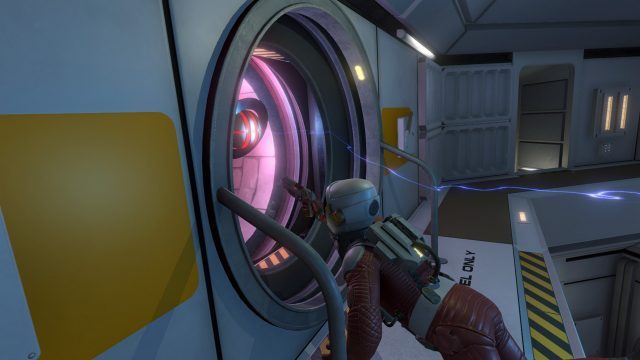Downward Spiral: Prologue (2017) is a sci-fi adventure game that takes you into a lovingly recreated ’70s retro future of CRT monitors and space stations abound. Featuring a single-player and coop mission, and multiplayer deathmatch mode Downward Spiral: Prologue feels like the creators have torn out the first few pages of an Arthur C. Clarke novel and realized it in virtual reality.
Downward Spiral: Prologue Details:
Official Site
Developer: 3rd Eye Studios Oy LTD
Available On: Steam (HTC Vive, Oculus Rift)
Reviewed On: HTC Vive, Oculus Touch
Release Date: March, 31st 2017
Gameplay
Generator power: offline. Life support: offline. Artificial gravity: offline.
You’re tossed in with little back story, but it’s clear what you have to do aboard what appears to be an abandoned space station orbiting Earth. Get systems back online and see what happens.
Grabbing the railing you propel yourself to the nearest airlock and enter the station. Because you’re in a microgravity environment, you have to stop yourself with your hand and navigate forward by pushing off walls, and using the world’s many hand railings and button-filled consoles for stability.
There’s a lot to like about Downward Spiral: Prologue, from its well-polished interiors to its innovative locomotion scheme that has you free-floating in space, but I wasn’t impressed at all by the 15-minute length of the game. That’s right, another short-lived VR game that’s selling for real money on Steam.
But if the short single player/coop mission doesn’t deter you, you’re in for some very cohesive art, some interesting exploration in what feels like a real space station and a satisfying conclusion of the little level that will definitely leave you wanting for more of everything. Considering this is the first installment of the game, which hasn’t gone through any sort of pre-funding scheme like Steam Early Access program or Kickstarter, purchasing the game at $9.99 (€9,99 or £6,99) means you’re directly funding the second installment.
There aren’t really any puzzles to speak of, as the action is mostly driven by a few neat little button-filled consoles that jump-start the station’s various processes. There are also a few enemies to dispatch with a pistol, but the world’s little electric robot enemies are laughably easy to kill. It seems the atmosphere around you is really the star of the show here.
Deathmatch allows up to eight players to experience the same zero gravity gunplay in “environments familiar to the story,” meaning the same map. I wasn’t able to get into a deathmatch during pre-release of the game, so I can’t speak to its entirety. This isn’t a “shooter” however, so I’m still mystified as to why there’s a deathmatch in the first place. I’ll be updating my impressions (and score if need be) as soon as I get into a match.
Immersion
At first it took me a few moments to get used to the locomotion style of floating around and pushing off the corridors of the space station, but after a little practice I was flying through the world with relative ease. I was surprised at just how good it was, similar to Oculus’ recently released Mission:ISS (2017).
Shooting the game’s pistols wasn’t an entirely a hitch-free experience. Aiming felt a little unnatural, a possible tribute to realism as my space suit didn’t entirely allow for free movement with the pistol. I found myself being more deliberate in how I aimed because of it though as my bullets zinged through the vast expanse of the engine room.
Getting zapped by a robot feels right. Your sight is slightly more red-tinted every time you take a hit, and the sound mutes ever so slightly the worse the onslaught.
I played the game with both the Oculus Rift (with Touch) and the HTC Vive. The game is an open 360 environment, so a 3-sensor set-up is a must for Rift players if you want to forget the Touch version’s snap-turn. As per usual, the stock Vive setup provided for a flawless 360-tracking experience.
Comfort
Floating in space can be stomach-turning, but it seems the developers have nailed the locomotion scheme in Downward Spiral: Prologue to a pretty fine degree.
Besides relying on an hand-held air compressor you find midway through that lets you bebop around with your own personal jet, you have to use a little physicality to push off and stop yourself with walls. Thankfully grabbing out for any and all parts of the ship lets you stop yourself, and you sort of settle into your forward motion after a while.
The HUD design also helps anchor you in the world, keeping nausea at bay. The video walk-through below (warning: the full game is completely spoiled below) shows a bit of the left side of helmet in the frame, but it’s really not so intrusive. The helmet design only slightly cuts off your horizontal field of view (FOV).
Despite having a temperamental belly when it comes to artificial locomotion (I made myself sick playing Mission ISS), Downward Spiral seems to have done everything in its power to limit nausea, and I walked away feeling surprisingly normal.





